Comparative Manufacturing of Hybrid Composites with Waste Graphite Fillers for UAVs
Abstract
1. Introduction
2. Materials and Methods
2.1. Materials
2.2. Prepared Specimens
2.3. Hand Lay-Up Process
2.4. Vacuum Infusion Process
2.5. Testing Specimens
3. Experimental Results and Discussion
3.1. Hand Lay-Up Process
3.2. Vacuum Infusion Process
3.3. Comparison with Aluminum
3.4. Fracture Characteristics
4. Conclusions
Author Contributions
Funding
Institutional Review Board Statement
Informed Consent Statement
Data Availability Statement
Conflicts of Interest
References
- Popov, V.V.; Pismenny, A.; Larionovsky, N.; Lapteva, A.; Safranchik, D. Corrosion Resistance of AI–CNT Metal Matrix Composites. Materials 2021, 14, 1–12. [Google Scholar]
- Wankhade, L.N.; Rathod, D.; Nukulwar, M.R.; Agrawal, E.S.; Chavhan, G.R. Characterization of Aluminium-Silicon Carbide Metal Matrix Composites. Mater. Today Proc. 2021, 44, 2740–2747. [Google Scholar] [CrossRef]
- Cho, J.; Chen, J.Y.; Daniel, I.M. Mechanical Enhancement of Carbon Fiber/Epoxy Composites by Graphite Nanoplatelet Reinforcement. Scr. Mater. 2007, 56, 685–688. [Google Scholar] [CrossRef]
- Salernitano, E.; Migliaresi, C. Composite Materials for Biomedical Applications: A Review. J. Appl. Biomater. Biomech. 2003, 1, 3–18. [Google Scholar]
- Agrawal, E.; Tungikar, V. Study on Tribological Properties of Al-TiC Composites by Taguchi Method. Mater. Today Proc. 2019, 26, 2242–2247. [Google Scholar]
- Muflikhun, M.A.; Yokozeki, T. Experimental and Numerical Analysis of CFRP-SPCC Hybrid Laminates for Automotive and Structural Applications with Cost Analysis Assessment. Compos. Struct. 2021, 263, 113707. [Google Scholar]
- Phunpeng, V.; Baiz, P.M. Mixed Finite Element Formulations for Strain-Gradient Elasticity Problems Using the FEniCS Environment. Finite Elem. Anal. Des. 2015, 96, 23–40. [Google Scholar] [CrossRef]
- Timmis, A.J.; Hodzic, A.; Koh, L.; Bonner, M.; Soutis, C.; Schäfer, A.W.; Dray, L. Environmental Impact Assessment of Aviation Emission Reduction through the Implementation of Composite Materials. Int. J. Life Cycle Assess. 2015, 20, 233–243. [Google Scholar] [CrossRef]
- Mishra, A.; Pal, S.; Singh, P. Design and Analysis of an Eight Rotor Co-Axial UAV Using Carbon Fiber Composites. Mater. Today Proc. 2022; in press. [Google Scholar]
- Dong, J.; He, B. Novel Fuzzy PID-Type Iterative Learning Control for Quadrotor UAV. Sensors 2019, 19, 24. [Google Scholar] [CrossRef] [PubMed]
- Sliseris, J.; Rocens, K. Optimal Design of Composite Plates with Discrete Variable Stiffness. Compos. Struct. 2013, 98, 15–23. [Google Scholar] [CrossRef]
- William, D.; Callister, D.G.R., Jr. Materials Science and Engineering: An Introduction, 10th ed.; John Wiley & Sons Inc.: Hoboken, NJ, USA, 2018; Volume 12. [Google Scholar]
- Meng, F.; Cui, Y.; Pickering, S.; McKechnie, J. From Aviation to Aviation: Environmental and Financial Viability of Closed-Loop Recycling of Carbon Fibre Composite. Compos. B Eng. 2020, 200, 108362. [Google Scholar] [CrossRef]
- Burande, S.W.; Bhope, D.V. Evaluation and Validation of Mechanical Properties of Steel Strip Embedded Unidirectional E-Glass Fiber Reinforced Hybrid Laminate. Mater. Today Proc. 2020, 42, 693–699. [Google Scholar] [CrossRef]
- Mahmoud Zaghloul, M.Y.; Yousry Zaghloul, M.M.; Yousry Zaghloul, M.M. Developments in Polyester Composite Materials—An in-Depth Review on Natural Fibres and Nano Fillers. Compos. Struct. 2021, 278, 114698. [Google Scholar] [CrossRef]
- Javadian, A.; Smith, I.F.C.; Saeidi, N.; Hebel, D.E. Mechanical Properties of Bamboo through Measurement of Culm Physical Properties for Composite Fabrication of Structural Concrete Reinforcement. Front. Mater. 2019, 6, 15. [Google Scholar] [CrossRef]
- Anuar, H.; Zuraida, A. Improvement in Mechanical Properties of Reinforced Thermoplastic Elastomer Composite with Kenaf Bast Fibre. Compos. B Eng. 2011, 42, 462–465. [Google Scholar] [CrossRef]
- Kulkarni, H.B.; Mahamuni, S.S.; Gaikwad, P.M.; Pula, M.A.; Mahamuni, S.; Bansode, S.H.; Kulkarni, A.A.; Shete, Y.B.; Nehatrao, S.A. Enhanced Mechanical Properties of Epoxy/Graphite Composites. Int. J. Adv. Eng. Res. Stud. E 2017, 6, 1–4. [Google Scholar]
- Marat-Mendes, R.; Rodrigues, I.; Figueiredo-Pina, C.G. Evaluation of Tribological Performance of Carbon Fibre Reinforced Epoxy Composites Loaded with Graphite Platelets under Reciprocating Linear Motion. Proc. Inst. Mech. Eng. Part J J. Eng. Tribol. 2019, 233, 1415–1423. [Google Scholar] [CrossRef]
- Ahlatcıoğlu, Ö.E.; Şenkal, B.F.; Okutan, M. Preparation and Characterization of Graphite Composites of Polyaniline. Microelectron Eng. 2015, 146, 76–80. [Google Scholar] [CrossRef]
- Bhagat, S.; Kumar Verma, P. Effect of Graphite Filler on Mechanical Behavior of Epoxy Composites. Int. J. Emerg. Technol. Adv. Eng. 2013, 3, 427–430. [Google Scholar]
- Megahed, M.; Megahed, A.A.; Agwa, M.A. The Influence of Incorporation of Silica and Carbon Nanoparticles on the Mechanical Properties of Hybrid Glass Fiber Reinforced Epoxy. J. Ind. Text. 2019, 49, 181–199. [Google Scholar] [CrossRef]
- Hulugappa, B.; Achutha, M.V.; Suresha, B. Effect of Fillers on Mechanical Properties and Fracture Toughness of Glass Fabric Reinforced Epoxy Composites. J. Miner. Mater. Charact. Eng. 2016, 4, 62704. [Google Scholar] [CrossRef]
- Sathish, S.; Kumaresan, K.; Prabhu, L.; Gokulkumar, S. Experimental Investigation of Mechanical and Ftir Analysis of Flax Fiber/Epoxy Composites Incorporating SiC, Al2O3 and Graphite. Rev. Romana Mater./Rom. J. Mater. 2018, 48, 476–482. [Google Scholar]
- Shivamurthy, B.; Udaya Bhat, K.; Anandhan, S. Mechanical and Sliding Wear Properties of Multi-Layered Laminates from Glass Fabric/Graphite/Epoxy Composites. Mater. Des. 2013, 44, 136–143. [Google Scholar] [CrossRef]
- Krishnaraj, C.; Vaira Vignesh, R. Characterization of Hybrid Black Toner Using the Parameters Waste Toner and Nano Phase Carbon. ARPN J. Eng. Appl. Sci. 2015, 10, 6135–6139. [Google Scholar]
- Kaipannan, S.; Govindarajan, K.; Sundaramoorthy, S.; Marappan, S. Waste Toner-Derived Carbon/Fe3O4 Nanocomposite for High-Performance Supercapacitor. ACS Omega 2019, 4, 15798–15805. [Google Scholar] [CrossRef]
- He, B.; Wang, B.; Wang, Z.; Qi, S.; Tian, G.; Wu, D. Mechanical Properties of Hybrid Composites Reinforced by Carbon Fiber and High-Strength and High-Modulus Polyimide Fiber. Polymer 2020, 204, 122830. [Google Scholar] [CrossRef]
- Jagannatha, T.D.; Harish, G. Mechanical Properties of Carbon/Glass Fiber Reinforced Epoxy Hybrid Polymer Composites. Int. J. Mech. Eng. Rob. Res. 2015, 4, 131–137. [Google Scholar]
- Forintos, N.; Czigany, T. Multifunctional Application of Carbon Fiber Reinforced Polymer Composites: Electrical Properties of the Reinforcing Carbon Fibers—A Short Review. Compos. B Eng. 2019, 162, 331–343. [Google Scholar] [CrossRef]
- Meng, F.; McKechnie, J.; Turner, T.; Wong, K.H.; Pickering, S.J. Environmental Aspects of Use of Recycled Carbon Fiber Composites in Automotive Applications. Environ. Sci. Technol. 2017, 51, 12727–12736. [Google Scholar] [CrossRef] [PubMed]
- Morioka, K.; Tomita, Y. Effect of Lay-up Sequences on Mechanical Properties and Fracture Behavior of CFRP Laminate Composites. Mater. Charact. 2000, 45, 125–136. [Google Scholar] [CrossRef]
- Naghipour, P.; Bartsch, M.; Chernova, L.; Hausmann, J.; Voggenreiter, H. Effect of Fiber Angle Orientation and Stacking Sequence on Mixed Mode Fracture Toughness of Carbon Fiber Reinforced Plastics: Numerical and Experimental Investigations. Mater. Sci. Eng. A 2010, 527, 509–517. [Google Scholar] [CrossRef]
- Neumeister, J.; Jansson, S.; Leckie, F. The Effect of Fiber Architecture on the Mechanical Properties of Carbon/Carbon Fiber Composites. Acta Mater. 1996, 44, 573–585. [Google Scholar] [CrossRef]
- Ary Subagia, I.D.G.; Kim, Y.; Tijing, L.D.; Kim, C.S.; Shon, H.K. Effect of Stacking Sequence on the Flexural Properties of Hybrid Composites Reinforced with Carbon and Basalt Fibers. Compos. B Eng. 2014, 58, 251–258. [Google Scholar] [CrossRef]
- Baptista, R.; Mendão, A.; Guedes, M.; Marat-Mendes, R. An Experimental Study on Mechanical Properties of Epoxy—Matrix Composites Containing Graphite Filler. Procedia Struct. Integr. 2016, 1, 74–81. [Google Scholar] [CrossRef]
- Kim, S.Y.; Shim, C.S.; Sturtevant, C.; Kim, D.D.W.; Song, H.C. Mechanical Properties and Production Quality of Hand-Layup and Vacuum Infusion Processed Hybrid Composite Materials for GFRP Marine Structures. Int. J. Nav. Archit. Ocean Eng. 2014, 6, 723–736. [Google Scholar] [CrossRef]
- Boransan, W.; Kerdphol, T.; Phunpeng, V. Experimental Manufacturing Methods of Glass Fiber Composites Considering Flexural Behaviour. Spektrum Ind. 2021, 19, 87–95. [Google Scholar] [CrossRef]
- Saensuriwong, K.; Kerdphol, T.; Phunpeng, V. Laboratory Study of Polypropylene-Based Honeycomb Core for Sandwich Composites. Spektrum Ind. 2021, 19, 97–104. [Google Scholar] [CrossRef]
- Muflikhun, M.A.; Yokozeki, T. Steel Plate Cold Commercial—Carbon Fiber Reinforced Plastics Hybrid Laminates for Automotive Applications: Curing Perspective with Thermal Residual Effect. J. Mater. Res. Technol. 2021, 14, 2700–2714. [Google Scholar] [CrossRef]
- Goren, A.; Atas, C. Manufacturing of Polymer Matrix Composites Using Vacuum Assisted Resin Infusion Molding. Arch. Mater. Sci. Eng. 2008, 34, 117–120. [Google Scholar]
- Jayalakshmi, C.G.; Anand, A.; Kandasubramanian, B.; Joshi, M. High Temperature Composite Materials for Electromagnetic Applications through a Cost Effective Manufacturing Process; Resin Film Infusion. Mater. Today Proc. 2019, 33, 1–6. [Google Scholar] [CrossRef]
- Gajjar, T.; Shah, D.B.; Joshi, S.J.; Patel, K.M. Analysis of Process Parameters for Composites Manufacturing Using Vacuum Infusion Process. Mater. Today Proc. 2020, 21, 1244–1249. [Google Scholar] [CrossRef]
- Kim, Y.H.; Eum, S.H.; Choi, B.K.; Kim, J.C.; Kwon, S.C.; Dutta, P.K. A Study on the Dimensional Stability of Interior Composite Panel Made by Vacuum Bagging and Hand Lay-up Fabrication Method. In Key Engineering Materials; Trans Tech Publication: Stafa-Zurich, Switzerland, 2004; Volume 261–263, pp. 1493–1498. [Google Scholar]
- Koushyar, H.; Alavi-Soltani, S.; Minaie, B.; Violette, M. Effects of Variation in Autoclave Pressure, Temperature, and Vacuum-Application Time on Porosity and Mechanical Properties of a Carbon Fiber/Epoxy Composite. J. Compos. Mater. 2012, 46, 1985–2004. [Google Scholar] [CrossRef]
- Ghasemi, A.R.; Moradi, M. Low Thermal Cycling Effects on Mechanical Properties of Laminated Composite Materials. Mech. Mater. 2016, 96, 126–137. [Google Scholar] [CrossRef]
- Guellali, M.; Oberacker, R.; Hoffmann, M.J. Influence of the Matrix Microstructure on the Mechanical Properties of CVI-Infiltrated Carbon Fiber Felts. Carbon 2005, 43, 1954–1960. [Google Scholar] [CrossRef]
- Jia, Z.; Li, T.; Chiang, F.P.; Wang, L. An Experimental Investigation of the Temperature Effect on the Mechanics of Carbon Fiber Reinforced Polymer Composites. Compos. Sci. Technol. 2018, 154, 53–63. [Google Scholar] [CrossRef]
- Aldajah, S.; Haik, Y. Transverse Strength Enhancement of Carbon Fiber Reinforced Polymer Composites by Means of Magnetically Aligned Carbon Nanotubes. Mater. Des. 2012, 34, 379–383. [Google Scholar] [CrossRef]
- Rihayat, T.; Salim, S.; Audina, N.; Khan, N.S.P.; Zaimahwati, Z.; Sami, M.; Yunus, M.; Salisah, Z.; Alam, P.N.; Saifuddin, S.; et al. Composite material making from empty fruit bunches of palm oil (EFB) and Ijuk (Arengapinnata) using plastic bottle waste as adhesives. In Proceedings of the IOP Conference Series: Materials Science and Engineering, Banda Aceh, Indonesia, 20–21 September 2017; Volume 334, pp. 1–7. [Google Scholar]
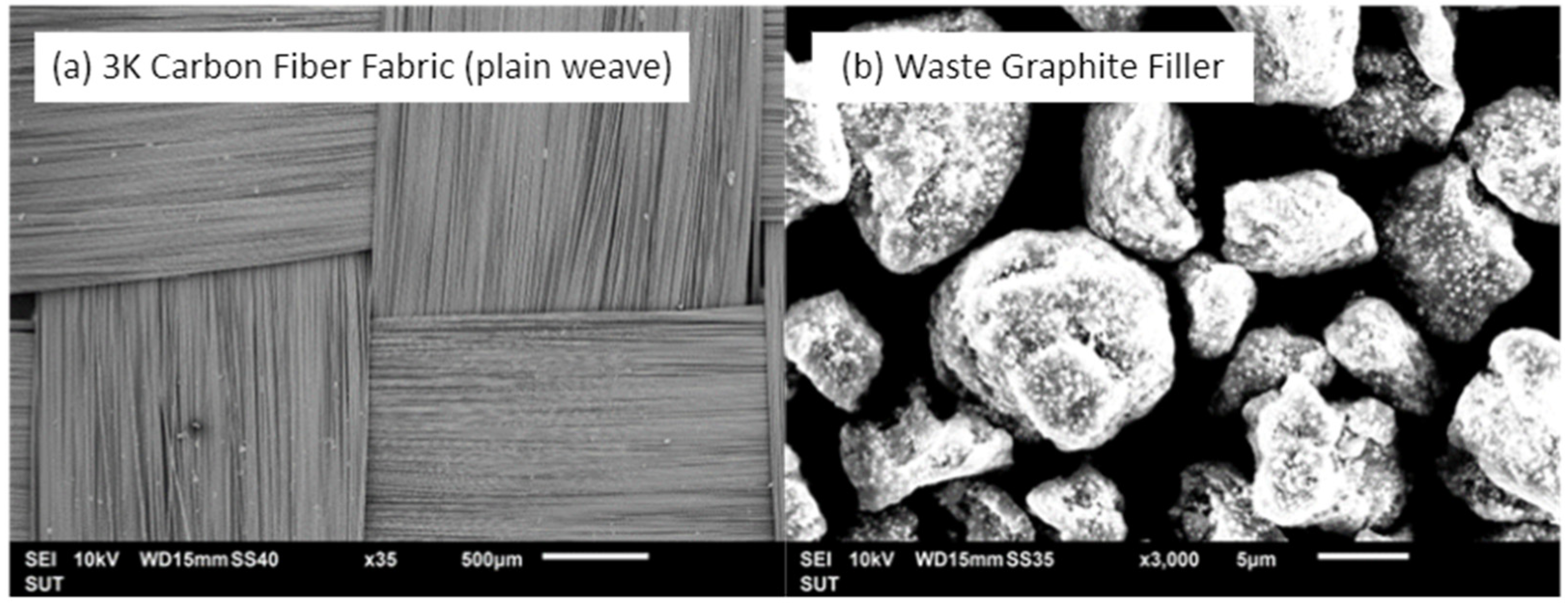


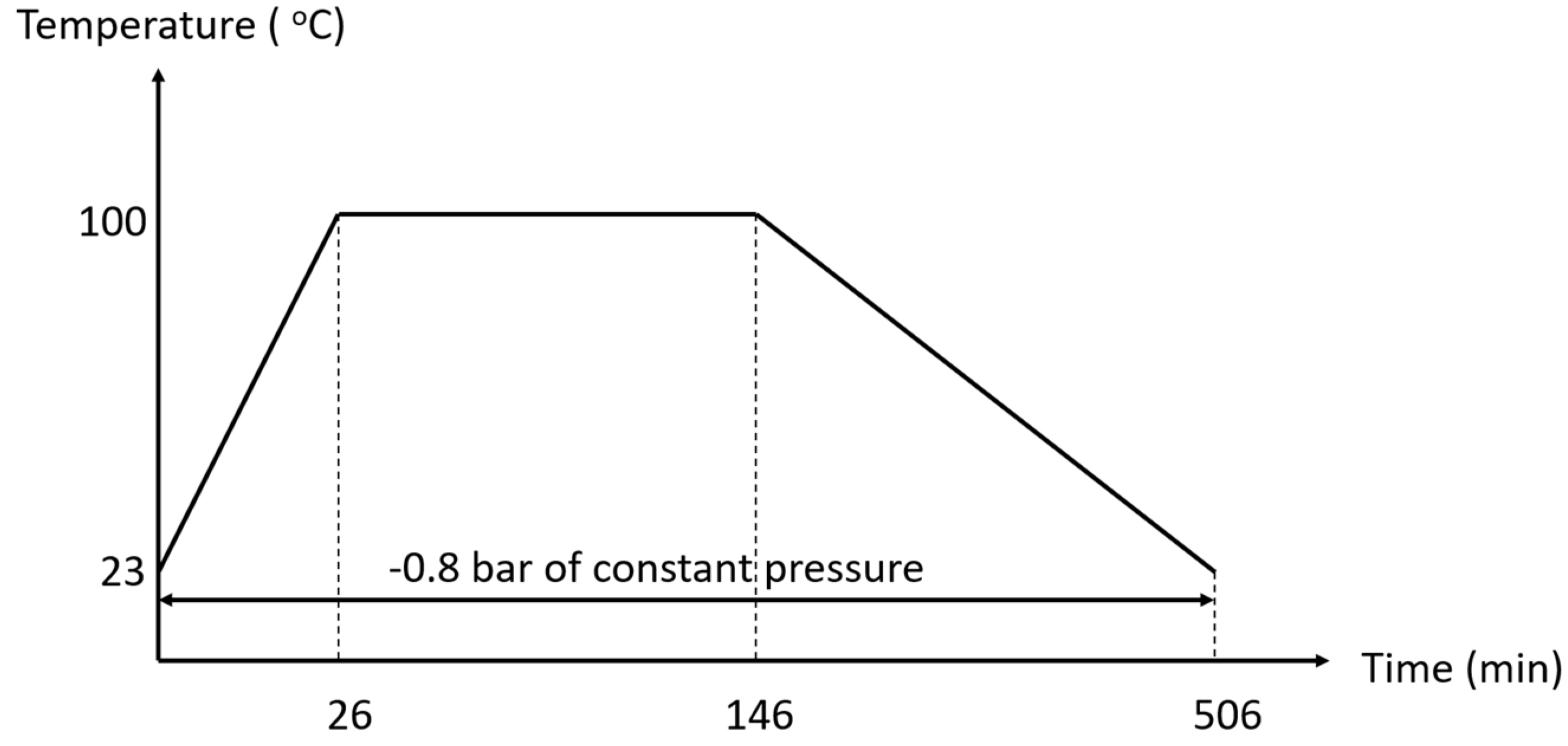
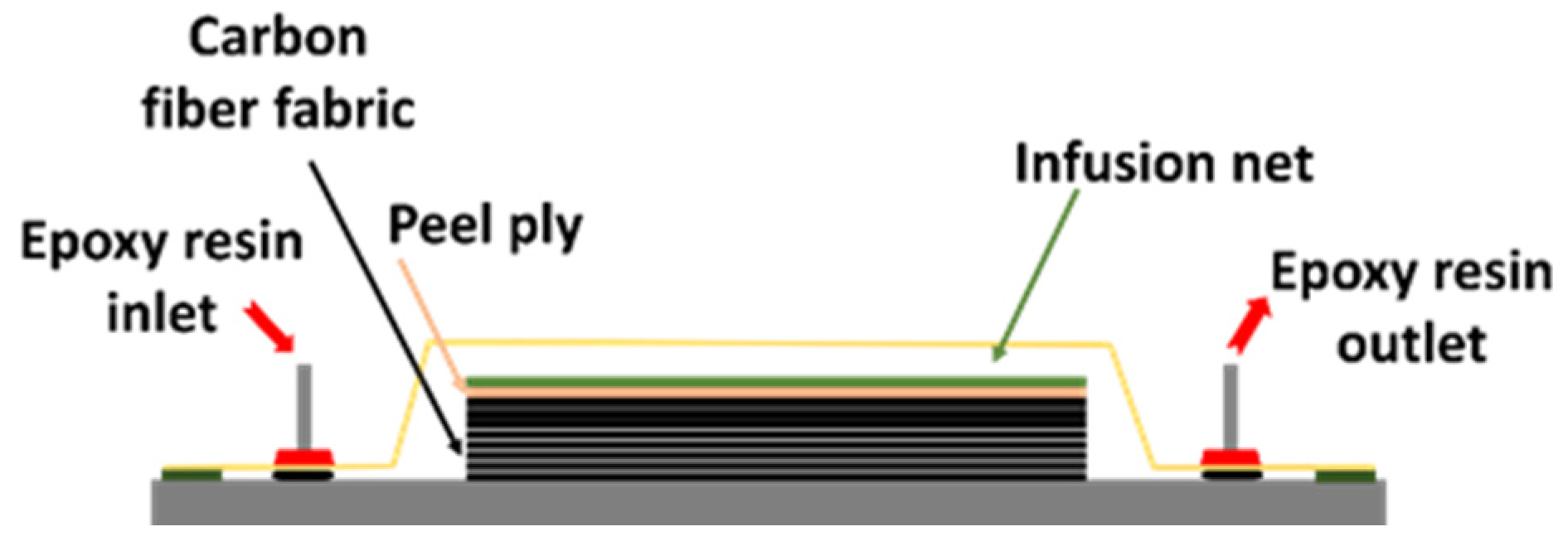
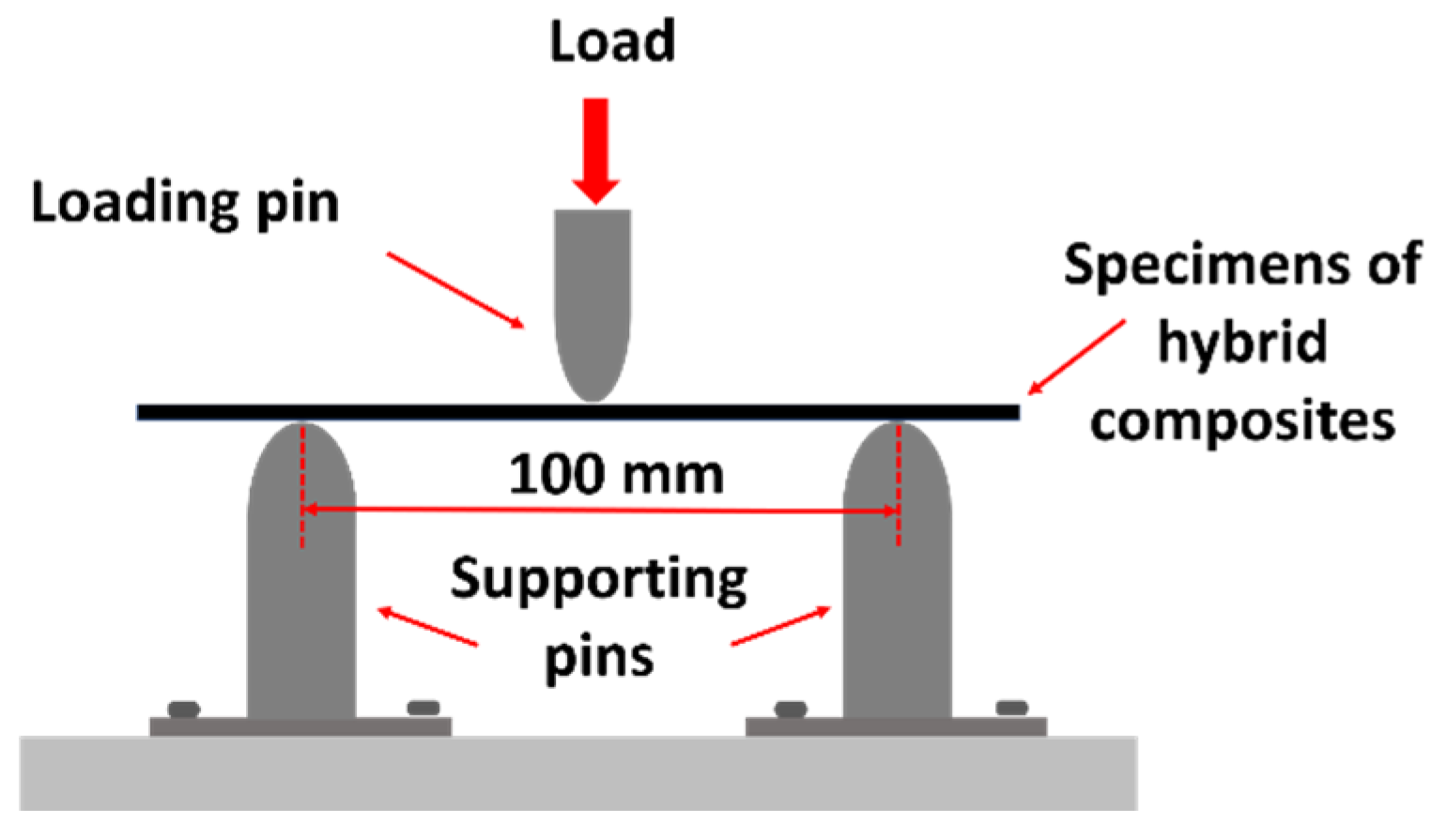
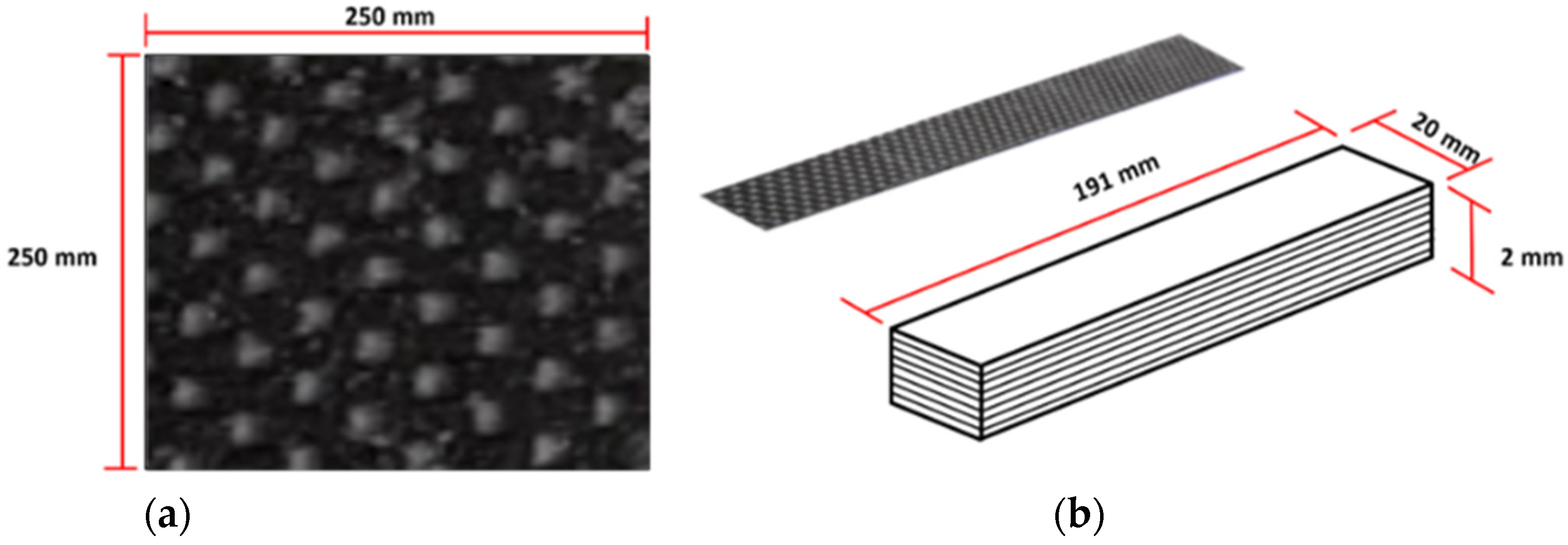
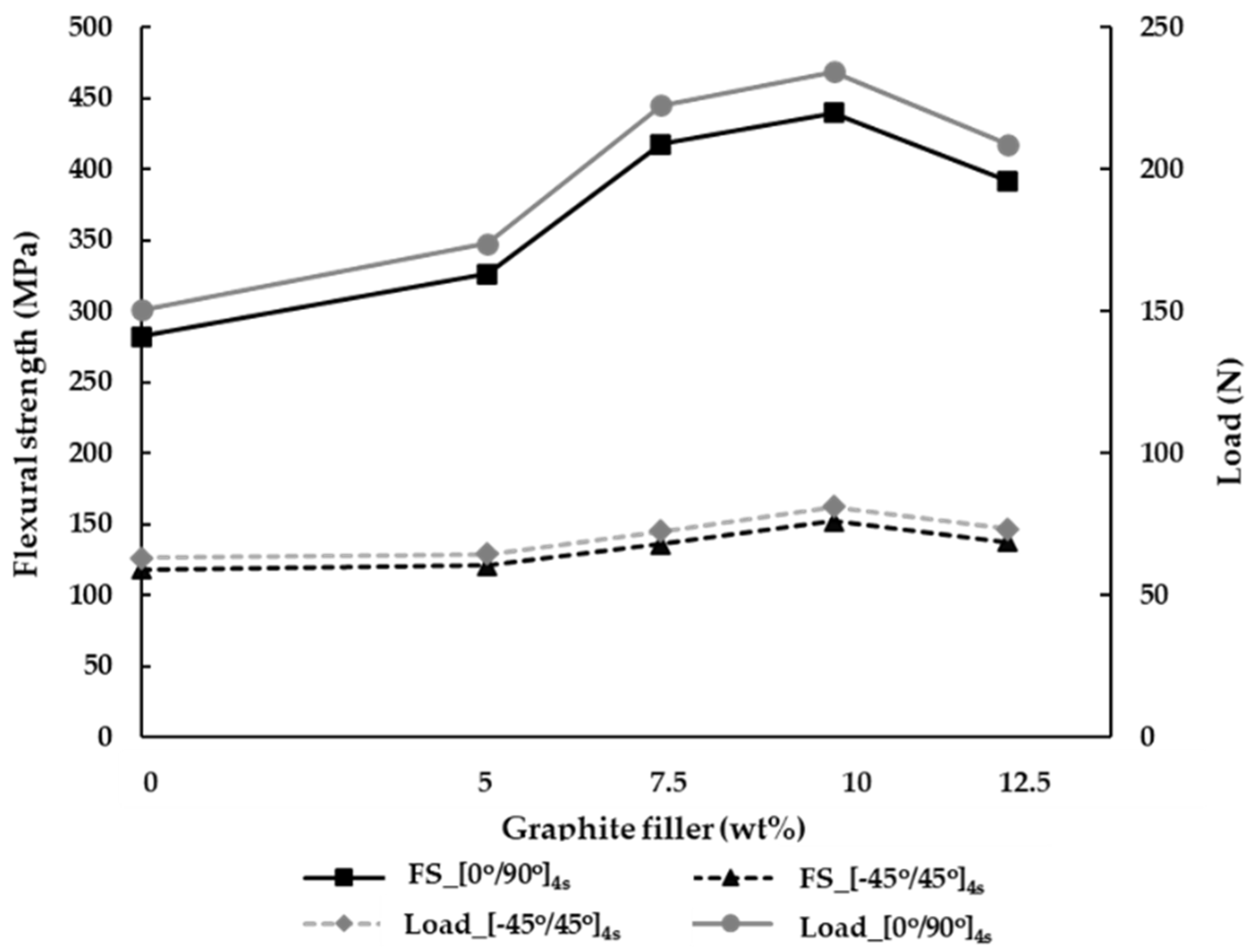
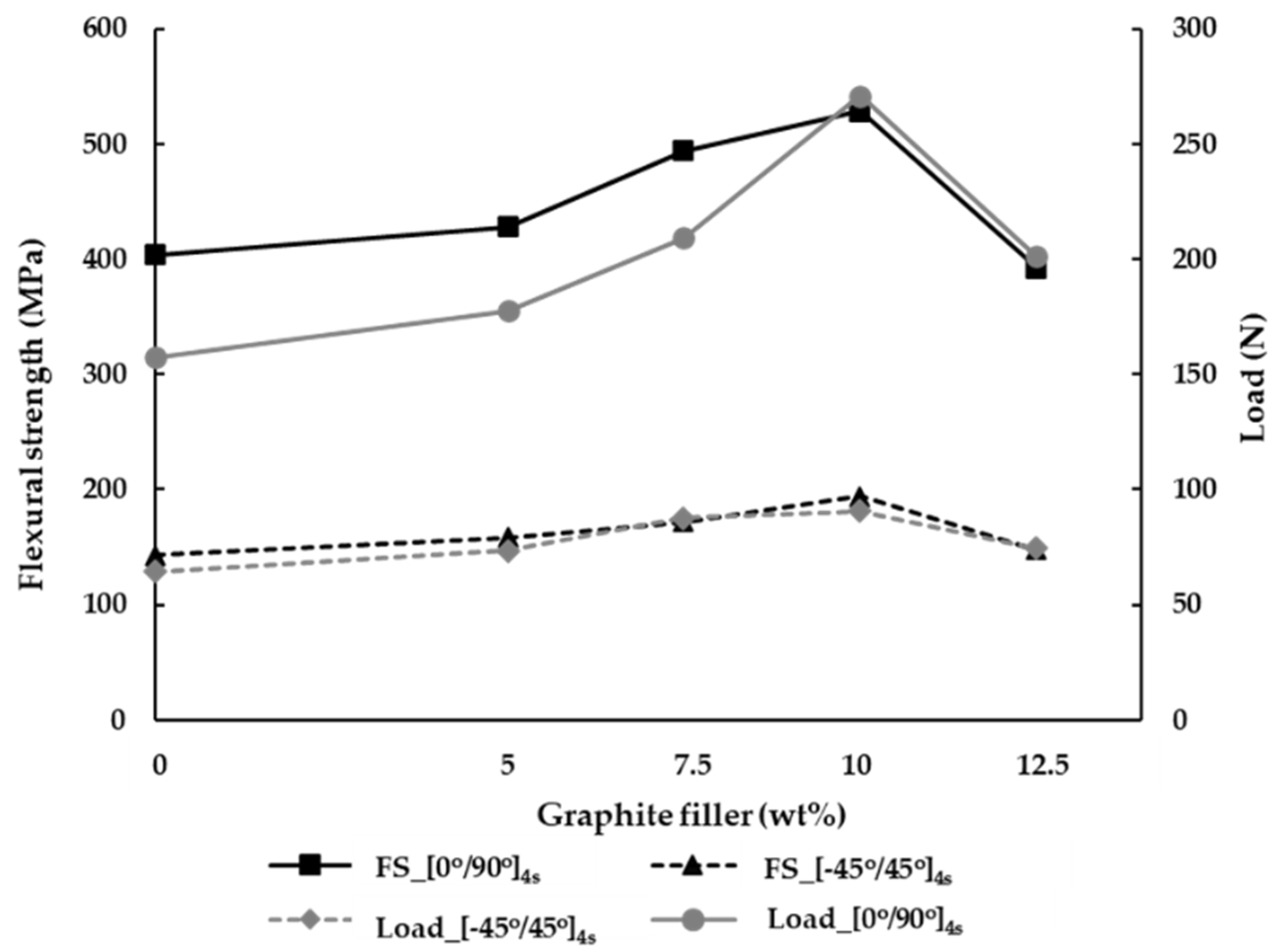
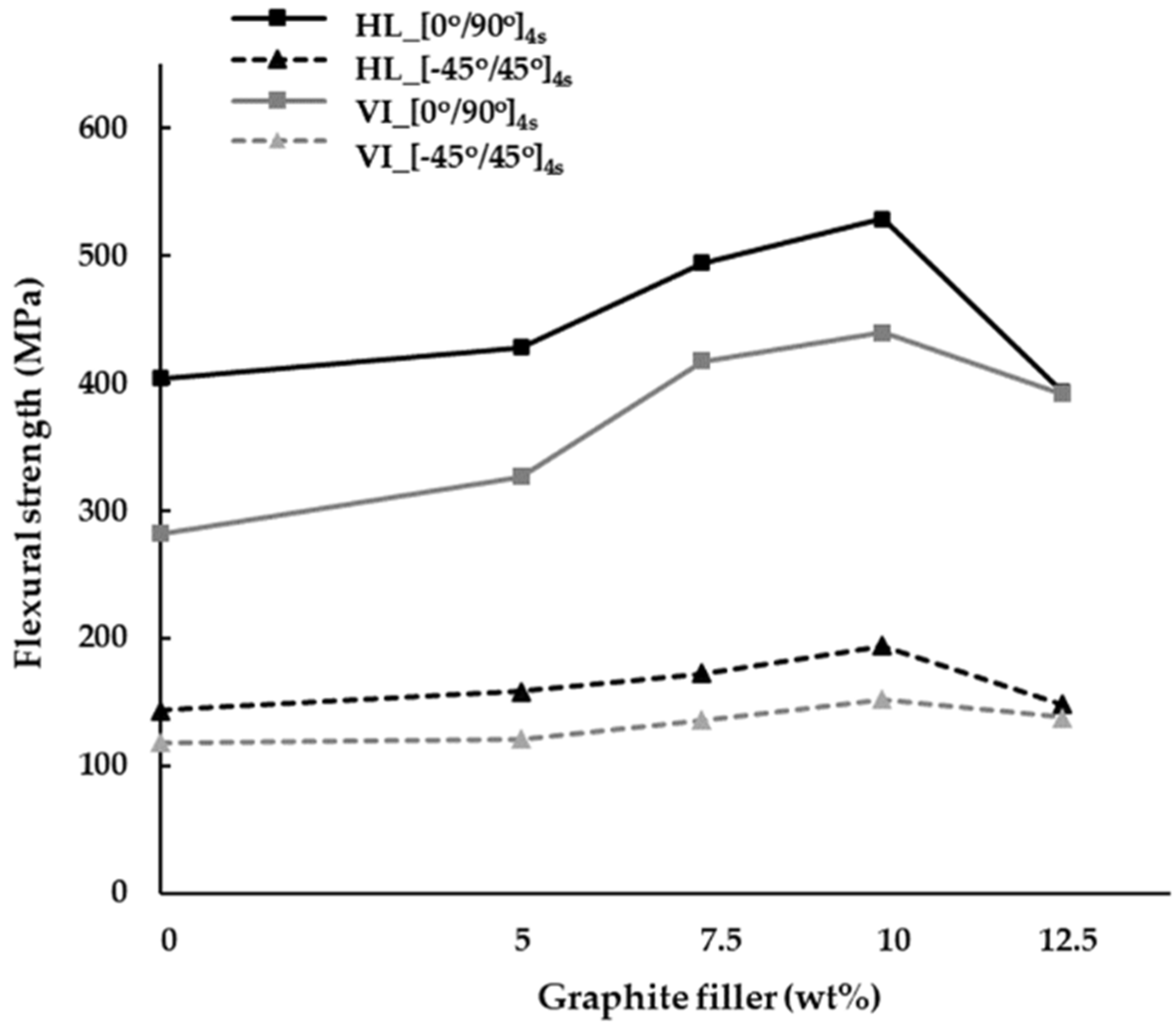
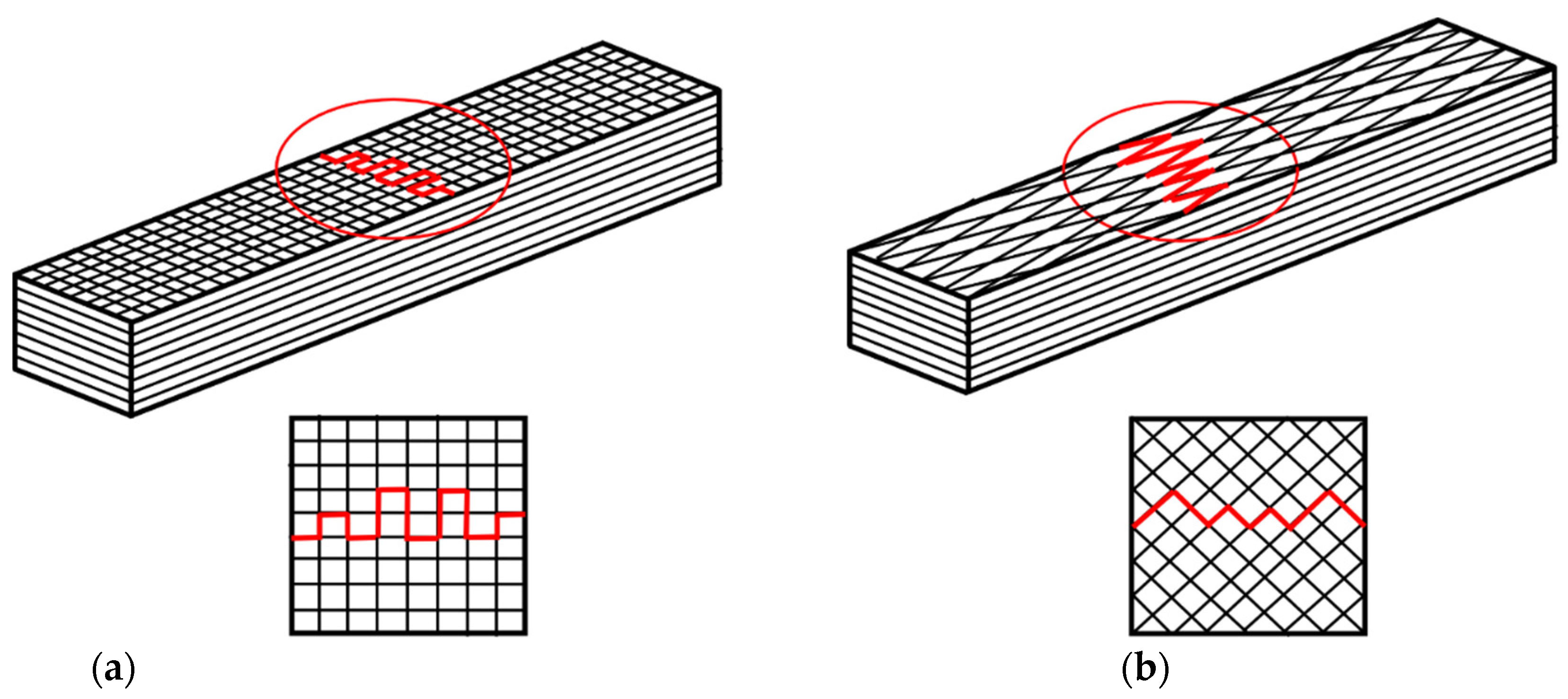
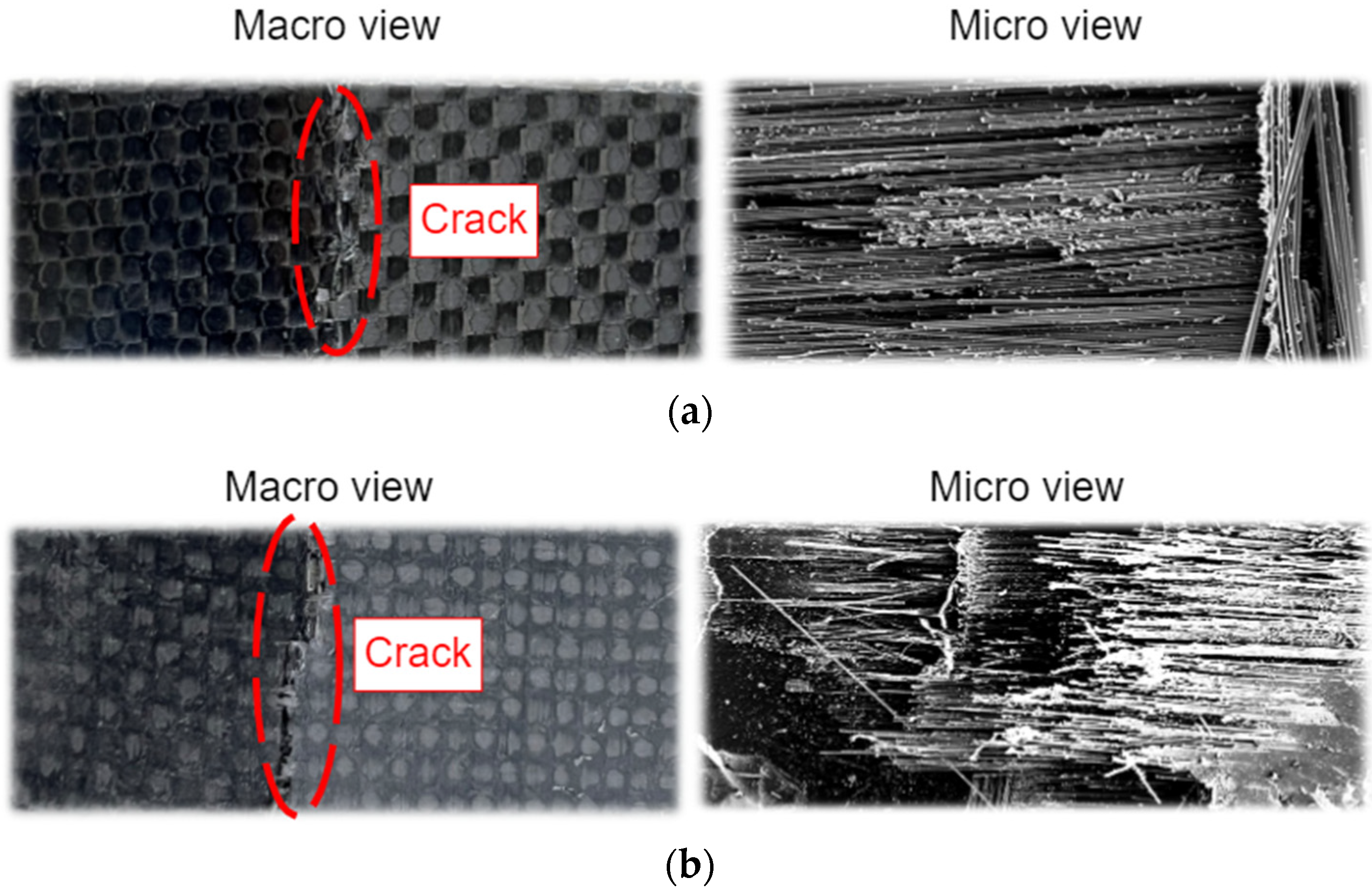

| Specimens | Reinforcement | Graphite Filler (wt%) | Process |
|---|---|---|---|
| 1 | [0°/90°]4s | 0 | Hand lay-up (HL) |
| 2 | 5 | ||
| 3 | 7.5 | ||
| 4 | 10 | ||
| 5 | 12.5 | ||
| 6 | [−45°/45°]4s | 0 | |
| 7 | 5 | ||
| 8 | 7.5 | ||
| 9 | 10 | ||
| 10 | 12.5 | ||
| 11 | [0°/90°]4s | 0 | Vacuum infusion (VI) |
| 12 | 5 | ||
| 13 | 7.5 | ||
| 14 | 10 | ||
| 15 | 12.5 | ||
| 16 | [−45°/45°]4s | 0 | |
| 17 | 5 | ||
| 18 | 7.5 | ||
| 19 | 10 | ||
| 20 | 12.5 |
| Materials | Flexural Strength (MPa) | Weight (g) | Strength-to-Mass Ratio (MPa/g) |
|---|---|---|---|
| Pure aluminum Alloy 6061 | 187.5 | 27 | 6.9 |
| Hybrid composites by HL | 439.4 | 11.75 | 37.4 |
| Hybrid composites by VI | 528.6 | 10 | 52.9 |
Publisher’s Note: MDPI stays neutral with regard to jurisdictional claims in published maps and institutional affiliations. |
© 2022 by the authors. Licensee MDPI, Basel, Switzerland. This article is an open access article distributed under the terms and conditions of the Creative Commons Attribution (CC BY) license (https://creativecommons.org/licenses/by/4.0/).
Share and Cite
Phunpeng, V.; Saensuriwong, K.; Kerdphol, T. Comparative Manufacturing of Hybrid Composites with Waste Graphite Fillers for UAVs. Materials 2022, 15, 6840. https://doi.org/10.3390/ma15196840
Phunpeng V, Saensuriwong K, Kerdphol T. Comparative Manufacturing of Hybrid Composites with Waste Graphite Fillers for UAVs. Materials. 2022; 15(19):6840. https://doi.org/10.3390/ma15196840
Chicago/Turabian StylePhunpeng, Veena, Karunamit Saensuriwong, and Thongchart Kerdphol. 2022. "Comparative Manufacturing of Hybrid Composites with Waste Graphite Fillers for UAVs" Materials 15, no. 19: 6840. https://doi.org/10.3390/ma15196840
APA StylePhunpeng, V., Saensuriwong, K., & Kerdphol, T. (2022). Comparative Manufacturing of Hybrid Composites with Waste Graphite Fillers for UAVs. Materials, 15(19), 6840. https://doi.org/10.3390/ma15196840








